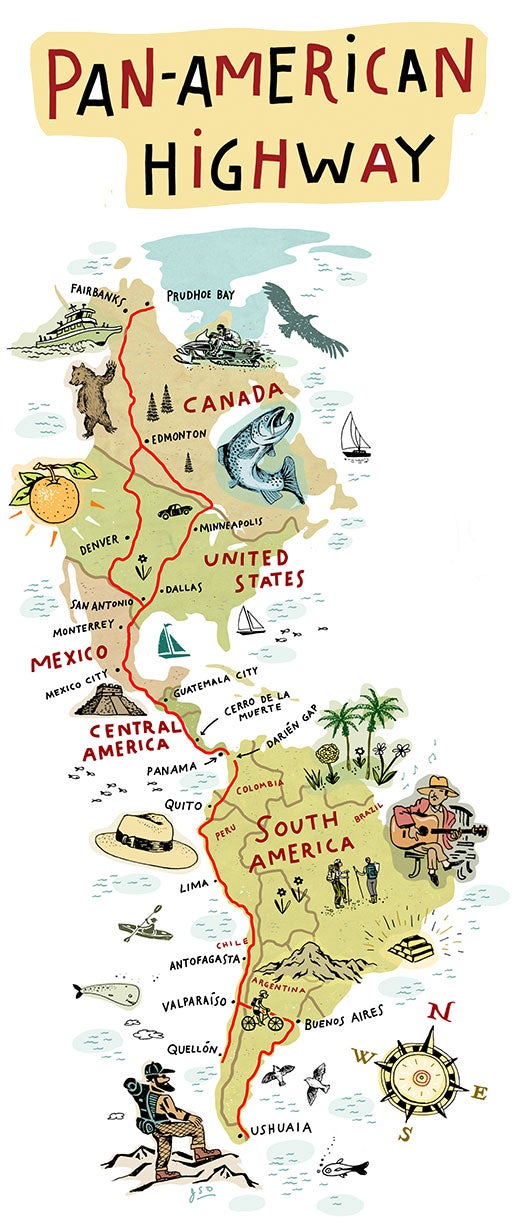World’s Longest Road: Story Behind the Pan-American Highway
The plans for land travel between the Americas started on a boat. The idea was hatched by a seasick Hinton Rowan Helper, the U.S. consul to Argentina, as he traveled from Buenos Aires to New York in late 1866 by way of the Lord Clarendon. It was the spark of an idea — an intercontinental railroad — that would launch 100 years of planning and politics and policy to bridge the continents, opening room for trade and mutually beneficial relations between the Americas.
Contrary to what historians have believed so far, says Rutkow, America’s first steps toward globalization found their footing on this railroad dream. “Pan-Americanism is not simply just this naked excuse for imperialism. It’s a very complicated phenomenon,” says Rutkow. “It’s very real, and it’s America’s first international relations of any consequence.”
The relationship over the past century has been complicated, to say the least. For some parts of Latin America, the relationship with the U.S. was diplomatic. For others, not so much.
“When it comes to Pan-Americanism,” says Yovanna Pineda, UCF associate professor of history, “Latin America is a very diverse place. In Central America, Pan-Americanism is seen as imperialistic, but as you get into Brazil and Argentina it becomes more diplomatic.”

And many of those U.S.-Latin American relations started with a railway dream. That railway never came to pass, but it led to a new route to connect the Americas: what would become known as the longest road in the world, stretching 19,000 miles from Alaska to the tip of Argentina.
Yet it’s the Panama Canal that gets all the Pan-American attention in the history books.
“I know 10 books right now all on the Panama Canal,” says Pineda. “It was such a huge venture, and also from the Latin American side, you see how many people actually died during the making of it. In a way, it was kind of like building the Great Wall of China.”
In the midst of all the literature on the canal — the politics, the race relations, the tragedies — the Pan-American Highway got lost.
“The road rarely received more than a passing mention in any of the literature,” says Rutkow, “and the more I searched, the more elusive the road seemed to become.”
There exists no clear definition of the Pan-American Highway, and the United States doesn’t officially recognize it today as such (though that’s what most travel bloggers and National Geographic writers will call it). Even travelers of the road don’t always know they’re on it.
“If you travel between capital cities, basically anywhere in Latin America, you’ll often find yourself on the Pan-American Highway,” says Rutkow. “Generally, the Pan-American Highway is just Highway 1 or 2 of the national system in most of South America.”
Information about the road itself is limited. Aside from the length of the road and the variety of terrains it crosses (from jungles to deserts to mountains to beaches), and the types of cultures you might encounter along the way, it is simply a road traveled, and certainly not often in its entirety. Some label the road as “the ultimate road trip.” As one travel blogger puts it: “Why settle for an ordinary road trip when you can drive across the Americas?”
But the road, for Rutkow, represents something much larger: The Pan-American Highway is the end result of negotiations, policies and ideas that started with a railway in the 1800s. Today, for Rutkow, the highway is a concrete example that we were wading into, and funding, international infrastructure decades before we thought.
Rutkow’s book, argues Gilbert Joseph, Farnam professor of history and international studies at Yale and Rutkow’s dissertation advisor, details a “missionary impulse to connect the hemispheres by roads, by railroads and then byways. … [Rutkow] is giving us many ways of looking at U.S. power that is personified by the Pan-American Highway.”
The footnote that Rutkow discovered in that book in Central America became a thread on which he pulled to unravel the plan for a railway and eventually the creation of the highway. And the discoveries Rutkow found along the way were surprising. The road itself was partly funded by New Deal funds, for example — a deal most consider a domestic policy.
“Franklin Roosevelt ended up having such an important role in pushing this forward right at a moment when it had no need to be,” says Rutkow. “I mean, it’s the Great Depression, and he’s the one demanding this happens.”
America had created the infrastructure for roads, and the automobile industry fueled that infrastructure — and now the government and private entities wanted to expand their reach. That reach is evident in American mega industry sites — spots of private enterprise sprinkled along the route.






